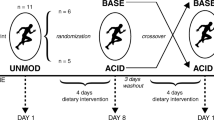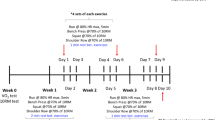Abstract
The purpose of this study was to investigate the effects of pre-exercise alkalosis on the physiological stress response to high-intensity exercise. Seven physically active males (age 22 ± 3 years, height 1.82 ± 0.06 m, mass 81.3 ± 8.4 kg and peak power output 300 ± 22 W) performed a repeated sprint cycle exercise following a dose of 0.3 g kg−1 body mass of sodium bicarbonate (NaHCO3) (BICARB), or a placebo of 0.045 g kg−1 body mass of sodium chloride (PLAC). Monocyte-expressed heat shock protein 72 (HSP72) and plasma thiobarbituric acid reactive substances (TBARS) were significantly attenuated in BICARB compared to PLAC (p = 0.04 and p = 0.039, respectively), however total anti-oxidant capacity, the ratio of oxidised to total glutathione, cortisol, interleukin 6 and interleukin 8 were not significantly induced by the exercise. In conclusion, monocyte-expressed HSP72 is significantly increased following high-intensity anaerobic exercise, and its attenuation following such exercise with the ingestion of NaHCO3 is unlikely to be due to a decreased oxidative stress.



Similar content being viewed by others
References
Baker AJ, Brandes R, Weiner MW (1995) Effects of intracellular acidosis on Ca2+ activation, contraction, and relaxation of frog skeletal muscle. Am J Physiol-Cell Physiol 268:C55–C63
Bird SR, Wiles J, Robbins J (1995) The effect of sodium bicarbonate ingestion on 1500-m racing time. J Sports Sci 13:399–403
Bishop D, Edge J, Davis C, Goodman C (2004) Induced metabolic alkalosis affects muscle metabolism and repeated-sprint ability. Med Sci Sport Exerc 36:807–813
Bouissou P, Defer G, Guezennec CY, Estrade PY, Serrurier B (1988) Metabolic and blood catecholamine responses to exercise during alkalosis. Med Sci Sport Exerc 20:228–232
Bracken RM, Linnane DM, Brooks S (2005) Alkalosis and the plasma catecholamine response to high-intensity exercise in man. Med Sci Sport Exerc 37:227–233
Burke LM, Pyne DB (2007) Bicarbonate loading to enhance training and competitive performance. Int J Sport Physiol Perform 2:93–97
Cairns SP (2006) Lactic acid and exercise performance—culprit or friend? Sports Med 36:279–291
Cameron SL, McLay-Cooke RT, Brown RC, Gray AR, Fairbairn KA (2010) Increased blood ph but not performance with sodium bicarbonate supplementation in elite rugby union players. Int J Sport Nutr Exerc Metab 20:307–321
Carr AJ, Gore CJ, Dawson B (2011) Induced alkalosis and caffeine supplementation: effects on 2,000-m rowing performance. Int J Sport Nutr Exerc Metab 21:357–364
Chase PB, Kushmerick MJ (1988) Effects of pH on contraction of rabbit fast and slow skeletal-muscle fibers. Biophys J 53:935–946
Demirbağ R, Yilmaz R, Güzel S, Çelik H, Koçyiğit A, Özcan E (2006) Effects of treadmill exercise test on oxidative/antioxidative parameters and DNA damage. Anatol J Cardiol 6:135–140
Finaud J, Lac G, Filaire E (2006) Oxidative stress—relationship with exercise and training. Sports Med 36:327–358
Gapen CJ, Moseley PL (1995) Acidosis alters the hyperthermic cytotoxicity and the cellular stress-response. J Therm Biol 20:321–325
Gibala MJ, Little JP, van Essen M, Wilkin GP, Burgomaster KA, Safdar A, Raha S, Tarnopolsky MA (2006) Short-term sprint interval versus traditional endurance training: similar initial adaptations in human skeletal muscle and exercise performance. J Physiol 575:901–911
Gohil K, Viguie C, Stanley WC, Brooks GA, Packer L (1988) Blood glutathione oxidation during human exercise. J Appl Physiol 64:115–119
Goldfinch J, McNaughton L, Davies P (1988) Induced metabolic alkalosis and its effects on 400-m racing time. Eur J Appl Physiol 57:45–48
Gomez-Cabrera M-C, Borrás C, Pallardó FV, Sastre J, Ji LL, Viña J (2005) Decreasing xanthine oxidase-mediated oxidative stress prevents useful cellular adaptations to exercise in rats. J Physiol 567:113–120
Hillman AR, Vince RV, Taylor L, McNaughton L, Mitchell N, Siegler J (2011) Exercise-induced dehydration with and without environmental heat stress results in increased oxidative stress. Appl Physiol Nutr Metab 36:1–9
Hood VL, Tannen RL (1998) Protection of acid-base balance by pH regulation of acid production. N Engl J Med 339:819–826
Juel C (2008) Regulation of pH in human skeletal muscle: adaptations to physical activity. Acta Physiol 193:17–24
Khassaf M, McArdle A, Esanu C, Vasilaki A, McArdle F, Griffiths RD, Brodie DA, Jackson MJ (2003) Effect of vitamin C supplements on antioxidant defence and stress proteins in human lymphocytes and skeletal muscle. J Physiol-Lond 549:645–652
Kohen R, Yamamoto Y, Cundy KC, Ames BN (1988) Antioxidant activity of carnosine, homocarnosine, and anserine present in muscle and brain. Proc Natl Acad Sci 85:3175–3179
Kurkcu R (2010) The effects of short-term exercise on the parameters of oxidant and antioxidant system in handball players. Afr J Pharm Pharmacol 4:448–452
Lavender G, Bird SR (1989) Effect of sodium bicarbonate ingestion upon repeated sprints. Br J Sport Med 23:41–45
Leelarugrayub N, Sutabhaha T, Pothongsunun P, Chanarat N (2005) Exhaustive exercise test and oxidative stress response in athletic and sedentary subjects. CMU J 4:183
Leggate M, Nowell M, Jones S, Nimmo M (2010) The response of interleukin-6 and soluble interleukin-6 receptor isoforms following intermittent high intensity and continuous moderate intensity cycling. Cell Stress Chaperon 15:827–833
Lindh AM, Peyrebrune MC, Ingham SA, Bailey DM, Folland JP (2008) Sodium bicarbonate improves swimming performance. Int J Sports Med 29:519–523
Madden LA, Sandstrom ME, Lovell RJ, McNaughton L (2008) Inducible heat shock protein 70 and its role in preconditioning and exercise. Amino Acids 34:511–516
Marx J, Gordon S, Vos N, Nindl B, Gómez A, Volek J, Pedro J, Ratamess N, Newton R, French D, Rubin M, Häkkinen K, Kraemer W (2002) Effect of alkalosis on plasma epinephrine responses to high intensity cycle exercise in humans. Eur J Appl Physiol 87:72–77
Maughan RJ, Greenhaff PL, Leiper JB, Ball D, Lambert CP, Gleeson M (1996) Diet composition and the performance of high-intensity exercise. J Sports Sci 15:265–275
McNaughton L, Dalton B, Palmer G (1999) Sodium bicarbonate can be used as an ergogenic aid in high-intensity, competitive cycle ergometry of 1 h duration. Eur J Appl Physiol 80:64–69
Meyer T, Gabriel HHW, Rätz M, Müller HJ, Kindermann W (2001) Anaerobic exercise induces moderate acute phase response. Med Sci Sport Exerc 33:549–555
Morton JP, MacLaren DP, Cable NT, Bongers T, Griffiths RD, Campbell IT, Evans L, Kayani A, McArdle A, Drust B (2006) Time course and differential responses of the major heat shock protein families in human skeletal muscle following acute nondamaging treadmill exercise. J Appl Physiol 101:176–182
Narasimhan P, Swanson RA, Sagar SM, Sharp FR (1996) Astrocyte survival and HSP70 heat shock protein induction following heat shock and acidosis. Glia 17:147–159
Nemet D, Meckel Y, Bar-Sela S, Zaldivar F, Cooper D, Eliakim A (2009) Effect of local cold-pack application on systemic anabolic and inflammatory response to sprint-interval training: a prospective comparative trial. Eur J Appl Physiol 107:411–417
Nielsen AR, Pedersen BK (2007) The biological roles of exercise-induced cytokines: IL-6, IL-8, and IL-15. Appl Physiol Nutr Metab 32:833–839
Ostrowski K, Hermann C, Bangash A, Schjerling P, Nielsen JN, Pedersen BK (1998) A trauma-like elevation of plasma cytokines in humans in response to treadmill running. J Physiol 513:889–894
Peart DJ, McNaughton LR, Midgley AW, Taylor L, Towlson C, Madden LA, Vince RV (2011) Pre-exercise alkalosis attenuates the heat shock protein 72 response to a single-bout of anaerobic exercise. J Sci Med Sport 14:435–440
Peart DJ, Siegler J, Vince RV (2012) Practical recommendations for coaches and athletes: a meta-analysis of sodium bicarbonate use for athletic performance. J Strength Cond Res. doi:10.1519/JSC.0b013e3182576f3d
Pedersen BK, Steensberg A, Fischer C, Keller C, Keller P, Plomgaard P, Febbraio M, Saltin B (2003) Searching for the exercise factor: Is il-6 a candidate? J Muscle Res Cell M 24:113–119
Powers SK, Smuder AJ, Kavazis AN, Hudson MB (2010) Experimental guidelines for studies designed to investigate the impact of antioxidant supplementation on exercise performance. Int J Sport Nutr Exerc Metab 20:2–14
Price MJ, Simons C (2010) The effect of sodium bicarbonate ingestion on high-intensity intermittent running and subsequent performance. J Strength Cond Res 24:1834–1842
Sandstrom ME, Madden LA, Taylor L, Siegler JC, Lovell RJ, Midgley A, McNaughton L (2009) Variation in basal heat shock protein 70 is correlated to core temperature in human subjects. Amino Acids 37:279–284
Siegler JC, Gleadall-Siddall DO (2010) Sodium bicarbonate ingestion and repeated swim sprint performance. J Strength Cond Res 24:3105–3111
Siegler JC, Keatley S, Midgley AW, Nevill AM, McNaughton LR (2008) Pre-exercise alkalosis and acid-base recovery. Int J Sports Med 29:545–551
Siegler JC, Midgley AW, Polman RCJ, Lever R (2010) Effects of various sodium bicarbonate loading protocols on the time-dependent extracellular buffering profile. J Strength Cond Res 24:2551–2557
Steinberg J, Delliaux S, Jammes Y (2006) Reliability of different blood indices to explore the oxidative stress in response to maximal cycling and static exercises. Clin Physiol Funct Imaging 26:106–112
Stokes K, Nevill M, Cherry P, Lakomy HA, Hall G (2004) Effect of 6 weeks of sprint training on growth hormone responses to sprinting. Eur J Appl Physiol 92:26–32
Tanskanen MM, Uusitalo AL, Kinnunen H, Hakkinen K, Kyrolainen H, Atatlay M (2011) Association of military training with oxidative stress and overreaching. Med Sci Sports Exerc 43:1552–1560
Taylor L, Midgley AW, Chrismas B, Madden LA, Vince RV, McNaughton L (2010a) The effect of acute hypoxia on heat shock protein 72 expression and oxidative stress in vivo. Eur J Appl Physiol 109:849–855
Taylor L, Midgley AW, Chrismas B, Madden LA, Vince RV, McNaughton LR (2010b) Daily quadratic trend in basal monocyte expressed HSP72 in healthy human subjects. Amino Acids 38:1483–1488
Vince R, Oliver K, Midgley A, McNaughton L, Madden L (2010) In vitro heat shock of human monocytes results in a proportional increase of inducible Hsp70 expression according to the basal content. Amino Acids 38:1423–1428
Wahl P, Zinner C, Achtzehn S, Bloch W, Mester J (2010) Effect of high- and low-intensity exercise and metabolic acidosis on levels of gh, igf-i, igfbp-3 and cortisol. Growth Horm IGF Res 20:380–385
Wilkes D, Gledhill N, Smyth R (1983) Effect of acute induced metabolic alkalosis on 800-m racing time. Med Sci Sport Exerc 15:277–280
Zabala, M, Peinado, A, Calderón, F, Sampedro, J, Castillo M, Benito P (2011) Bicarbonate ingestion has no ergogenic effect on consecutive all out sprint tests in BMX elite cyclists. Eur J Appl Physiol:1-8
Zajac A, Cholewa J, Poprzecki S, Waskiewicz Z, Langfort J (2009) Effects of sodium bicarbonate ingestion on swim performance in youth athletes. J Sport Sci Med 8:45–50
Acknowledgments
The authors wish to thank those who volunteered for the study, and declare there was no financial support for this research project. Additionally, we would like to thank Miss Bryna Chrismas for her assistance with pilot work and advice on statistical analysis. All subjects provided written informed consent in accordance with the departmental and university ethical procedures and following the principles outlined in the Declaration of Helsinki.
Author information
Authors and Affiliations
Corresponding author
Additional information
Communicated by Michael Lindinger.
Rights and permissions
About this article
Cite this article
Peart, D.J., Kirk, R.J., Hillman, A.R. et al. The physiological stress response to high-intensity sprint exercise following the ingestion of sodium bicarbonate. Eur J Appl Physiol 113, 127–134 (2013). https://doi.org/10.1007/s00421-012-2419-4
Received:
Accepted:
Published:
Issue Date:
DOI: https://doi.org/10.1007/s00421-012-2419-4




